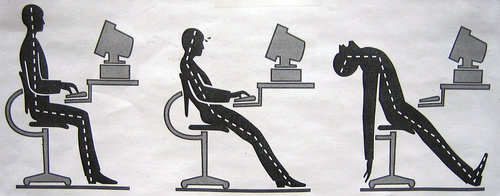Do you have pain sitting at your desk? Is it worse over time or at the end of the day? Does it improve with movement, exercise or stretching only to return again? Perhaps you’ve been told it’s because of poor posture. The solution could be surprisingly simple.

The notion of postural dysfunction is well documented in the current literature for many different injuries in particular back pain, and shoulder dysfunction. An example I see regularly as a physiotherapist would be in patients with altered neck, back or shoulder blade posture. People tend to dislike prolonged sitting (e.g. with work or study), carrying the shopping or often-in mothers, problems carrying young children. The common theme is always pain with prolonged postures/positions, eased by lying down (taking out the effect of gravity) or general movement of the sore area. Lots of patients improve with heat, massage or dry needling short-term without any long-term benefit. The missing component is addressing the underlying postural deficits, biomechanics, and altering the person’s problematic tasks that contribute to their symptoms.
Intermittent Ischaemic-based pain is the term used to describe pain associated with altered blood flow to an area of the body. When tissues are stretched for a period of time, there is an alteration in blood flow and changes in tissue pH, which stimulates a chemical and eventual hormonal response. If the posture or stretch is sustained this can become painful. If we stretch our index finger back as far as possible for example, it feels like a “stretching” sensation initially. If we sustain that position for a minute, it becomes painful. This as an example of ischaemic-based pain. The same type of reaction occurs in the neck, upper and lower back, and between the shoulder blades due to the effects of gravity on our bodies. The short-term solution is so simple. MOVE. With movement we restore the normal blood flow to the area, and avoid the ensuing chemical response. The challenge long-term with each person is to identify what biomechanical or strength deficits may be there, and provide an individualized program to improve those key components.
The relatively new concept of intermittent ischaemic-based pain is one we see everyday clinically. Exercise is the best medicine. If you have poor posture or pain with prolonged sitting, movement is the key.
Daniel has completed a Graduate Certificate in Sports Physiotherapy encompassing biomechanical analysis and recent advances in pain science. Please contact Lifecare Cottesloe or Lifecare Claremont for an appointment, detailed assessment and tailored treatment program specific to your condition.
Jones, L. E., & O’Shaughnessy, D. F. (2014). The pain and movement reasoning model: introduction to a simple tool for integrated pain assessment. Manual Therapy, 19(3), 270-276. doi:10.1016/j.math.2014.01.010
